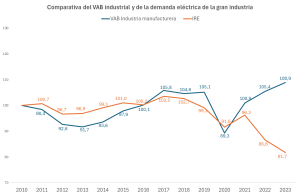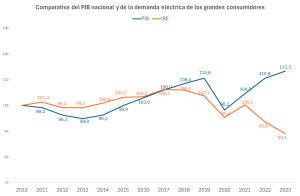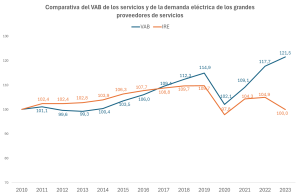The decline has been particularly significant since 2022, among other reasons due to more efficient energy management and the implementation of various self-consumption formulas
According to data from Redeia analyzed by Foro Industria y Energía (FIE) and the social research institute Opina 360, the demand for electrical energy from medium and large Spanish industries to the electrical grid has been decreasing almost uninterruptedly since the year 2018. This decrease has been particularly relevant during the years 2022 and 2023, where the decline compared to the reference indicator of the year 2010 is 13.4% and 18.3%, respectively.
The analysis exclusively examines the electricity demand data from those manufacturing industries that have contracted the 6.1 tariff, that is, with a power greater than 450 kW (medium or large).
Based on these figures, Foro Industria y Energía has consulted various experts on a series of issues related to energy management and industrial development:
Does this decline mean that the industry is consuming less electricity over time?
No. What happens, at least since 2022, is that the energy management of the industry is more efficient, and it also obtains a part of that energy outside the electrical grid, especially through the use of different self-consumption formulas. Since this year, there has been a very pronounced decrease in electricity demand from the grid, reaching 18.3% in 2023. However, this decline coincides with an increase in Gross Value Added (GVA), the indicator of economic activity reflecting the total value of all goods and services produced minus the value of those used for intermediate consumption in their production (See graph 1). Therefore, the situation is that, although there is apparently less demand for electricity, the volume of goods produced is growing, suggesting that the industry continues to use similar levels of electrical energy obtained through alternative means to the grid.
Graph 1: Comparison of the evolution of Gross Value Added (GVA) and the Electrical Grid Index (IRE) – Large Industry

Source: Opina 360 based on data from Red Eléctrica
Has the relationship between the increase in electricity consumption and industrial development “broken”?
No. What has changed is a part of the origin of the energy used and the efficiency of energy management. The industry is becoming more efficient, applying energy-saving solutions, and has other sources of energy available.
Is the medium and large Spanish industry growing?
Yes, but with many nuances. The GVA of the medium and large industry has returned in 2023 to levels similar to those of 2017 after many years of decline due, among other reasons, to the 2008 crisis, but it grows below the overall economy.
Thus, while the production of the medium and large industry grows by 8.9%, the GDP does so by 13.3% (see graph 2). And this data is even more relevant when compared to the rise of services, which grow by 21.5% (see graph 3). The medium and large Spanish manufacturing industry is growing, but it does so at a slower pace than the economy and much slower than the large services.
Graph 2: Comparison of the evolution of national GDP and the Electrical Grid Index (IRE) – Large Consumers

Source: Opina 360 based on data from INE and Red Eléctrica
Is the decline in energy demand from the grid widespread, or does it only occur in the medium and large industry?
Yes. Demand from the grid is declining in all business sectors of medium and large companies, according to Redeia data. However, there are substantial differences between them. While industrial demand from the grid has decreased by 18.3% compared to the 2010 indicator, that of large services has been decreasing in recent years until it equals the 2010 level. A possible interpretation is that the industry applies energy efficiency measures and self-consumption earlier.
Graph 3: Comparison of the evolution of GVA and the Electrical Grid Index (IRE) – Services

Source: Opina 360 based on data from INE and Red Eléctrica
In view of this data, is the improvement of the electrical grid still necessary?
Yes. It should not be overlooked that one of the functions of the electrical grid is to guarantee the energy security of the industry, that is, access to electrical energy. Regardless of demand, improving the electrical grid is necessary from various perspectives.
Firstly, it is foreseeable that the demand for electrical energy in medium and large industries will increase with the electrification process. Proof of this is the increase in off-site PPA agreements (Spain is a leader in this sector). In fact, in the first months of 2024, there is, for the first time since 2017, a year-on-year increase in the demand for electrical energy from the grid by these types of industries (excluding data related to the Covid-19 pandemic).
Secondly, an analysis from the more local perspective is necessary. Although Redeia does not provide data by autonomous communities, it is evident that the situation is not the same in different autonomous communities, and not all have the same level of demand. The grid must ensure that renewable energy reaches precisely those industries located in places where there is energy demand but more difficulties in generation or access to industrial-scale self-consumption solutions, such as the environments of large metropolitan concentrations like Madrid, Barcelona, or Valencia.
Does large industry self-consumption have a “glass ceiling”?
Probably yes, but it is still too early to know and quantify it. In the various activities that the Industry and Energy Forum has organized, in which important industrial companies have participated, most of them have stated that self-consumption allows them to cover between 15% and 25% of their energy needs. Obviously, it will depend a lot on the companies and their resources: while some companies can access on-site PPA with direct connections or build large photovoltaic parks on their land, others must limit themselves to their roofs. This coincidence between the data presented by companies from different sectors and locations suggests that there is a limit to the self-generated electrical energy that is not used in the grid, if only for the simple fact of their schedules. This issue makes the improvement of the electrical grid indispensable once again.
Final Note

